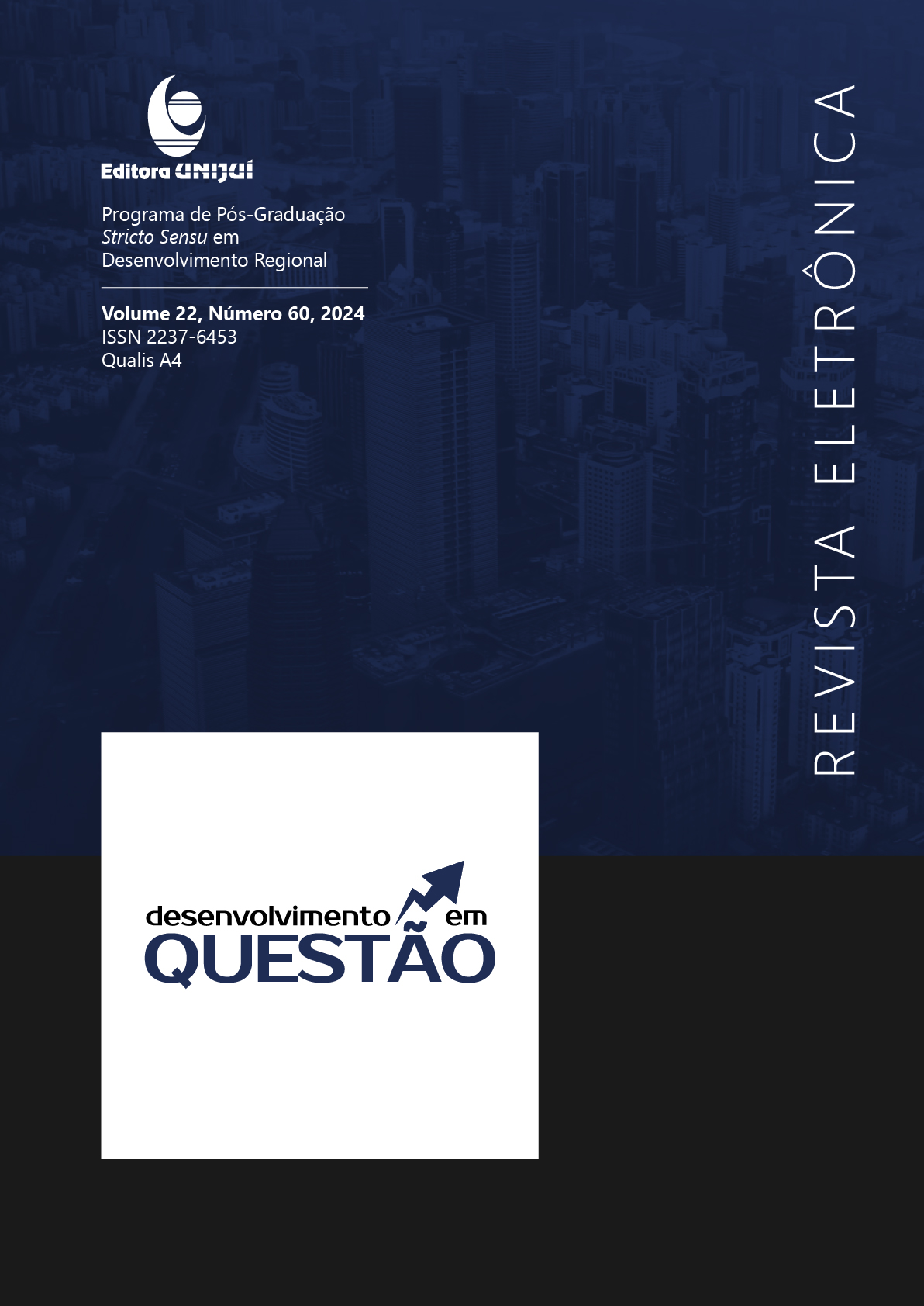Production factors, regional economic development and agriculture in Brazil: A spatial econometrics approach
DOI:
https://doi.org/10.21527/2237-6453.2024.60.14781Keywords:
Land, Labor, Technology, Exploratory Spatial Data AnalysisAbstract
Agriculture has a great effect on the development process of a region and production land, labor, and technology are determinant factors in its dynamism. This work carries out a spatial analysis for each production factor of Brazilian municipalities in 2006 and 2017 and intends to verify if there are patterns of association and agglomerations. This work is applied research of quantitative and exploratory nature. The Exploratory Analysis of Spatial Data (ESDA) was used to perform spatial analysis for each production factor in Brazilian municipalities in 2006 and 2017 and to check the patterns of association and agglomerations. The main agricultural activities and practice are related to exports as proposed by North. The formation of clusters verified both in the use of the factors of land, labor and technology, and in the value of agricultural production has a polarized role in the Brazilian space, as described by Perroux. This polarization and the formation of clusters expanded at certain points over time, indicating the formation of new links with neighboring municipalities (a la Hirschman). The spatial association pattern was significant in all analyzed variables, with emphasis on the non-physical technology factor, presenting the highest spatial autocorrelation coefficient in both periods analyzed.
References
ALMEIDA, E. Econometria espacial aplicada. Campinas: Alínea, 2012.
ALVES, E.; SOUZA, G. S.; MARRA, R. Uma viagem pelas regiões e Estados guiada pelo Censo Agropecuário 2006. Revista de Política Agrícola, v. 26, n. 1, p. 113-150, 2017.
ALVES, L. R. Reestruturação produtiva e desenvolvimento local: o caso do município de Toledo. 2016. Tese (Doutorado em Geografia, especialidade em Planejamento Regional e Urbano) – Universidade de Lisboa, Lisboa, 2016.
ANSELIN, L. Exploring spatial data with GeoDaTM: a workbook. Urbana-Champaign: Center for Spatially Integrated Social Science, 2005.
BENKO, G. A ciência regional. Oeiras: Celta, 1999.
BEZERRA, L. C.; CLEPS JUNIOR, J. O desenvolvimento agrícola da Região Centro-Oeste e as transformações no espaço agrário do Estado de Goiás. Caminhos de Geografia, v. 2, n. 12, p. 29-49, 2004.
BUAINAIN, A. M.; GARCIA, J. R.; VIEIRA FILHO, J. E. R. Dinâmica da economia e da agropecuária no Matopiba. Texto para discussão Ipea 2283. Rio de Janeiro: Ipea, 2017.
CHRISTALLER, W. Central places in Southern Germany. Englewood Cliffs: Pretince-Hall, 1966.
DALLABRIDA, V. R. Desenvolvimento regional: por que algumas regiões se desenvolvem e outras não? Santa Cruz do Sul: Edunisc, 2010.
DE JANVRY, A.; SADOULET, E. Agricultural growth and poverty reduction. World Bank Research Observer, v. 25, n. 1, p. 1-20, 2009. DOI: 10.1093/wbro/lkp015
DRUCIAKI, F. P. Desenvolvimento territorial: conceitos e elementos. In: BIDARRA, B. S.; VOLL, F. A.; FERRERA DE LIMA, J. Economia e desenvolvimento territorial. Foz do Iguaçu: Parque Itaipu, 2017.
DUARTE, J.; ALVES, E. O elemento invisível no progresso tecnológico. Revista de Política Agrícola, v. 25, n. 1, p. 122-124, 2016.
FAOSTAT. Food and Agriculture Organization of United Nations. Food and agriculture data. 2019 Disponível em: http://www.fao.org/faostat/ Acesso em: 8 ago. 2019.
FOTHERINGHAM, A.; BRUNSDON, C.; CHARLTON, M. Geographically weighted regression: the analysis of spatially varying relationships. Chichester, UK: Wiley, 2002.
FUJITA, M.; KRUGMAN, P.; VENABLES, A. J. Economia espacial: urbanização, prosperidade econômica e desenvolvimento humano no mundo. São Paulo: Futura, 2002.
GASQUES, J. G. et al. Total factor productivity in Brazilian agriculture. In: FUGLIE, K. O.; WANGS, S. L.; BALL, V. E. Productivity growth in agriculture: an international perspective. Oxfordshire: CAB International, 2012.
HIRSCHMAN, A. The strategy of economic development. New Haven: Yale University Press, 1958.
IBGE. Instituto Brasileiro de Geografia e Estatística. Censo agropecuário 2006. Sidra – Sistema de Recuperação Automática. 2006a. Disponível em: https://sidra.ibge.gov.br/pesquisa/censo-agropecuario/censo-agropecuario-2006. Acesso em: 1º jul. 2019.
IBGE. Instituto Brasileiro de Geografia e Estatística. Produção agrícola municipal. SIDRA – Sistema de Recuperação Automática. 2006b. Disponível em: https://sidra.ibge.gov.br/pesquisa/pam/tabelas. Acesso em: 1º jul. 2019.
IBGE. Instituto Brasileiro de Geografia e Estatística. Censo Agropecuário 2017. Sidra – Sistema de Recuperação Automática. 2017a. Disponível em: https://sidra.ibge.gov.br/pesquisa/censo-agropecuario/censo-agropecuario-2017. Acesso em: 1º jul. 2019.
IBGE. Instituto Brasileiro de Geografia e Estatística. Produção agrícola municipal. SIDRA – Sistema IBGE de Recuperação Automática. 2017b. Disponível em: https://sidra.ibge.gov.br/pesquisa/pam/tabelas. Acesso em: 1º jul. 2019.
IBGE. Instituto Brasileiro de Geografia e Estatística. Produto interno bruto dos municípios. SIDRA – Sistema de Recuperação Automática. 2017c. Disponível em: https://sidra.ibge.gov.br/pesquisa/pib-munic. Acesso em: 1º jul. 2019.
KEEBLE, D. E. Modelos de desenvolvimento econômico. In: CHORLEY, R. J.; HAGGETT, P. Modelos sócio-econômicos em geografia. Rio de Janeiro: Livros Técnicos e Científicos Editora, 1975.
LAPOLA, D. et al. Pervasive transition of the Brazilian land-use system. Nature Climate Change, v. 4, p. 27-35, 2013. DOI: https://doi.org/10.1038/nclimate2056
LÖSCH, A. The economics of location. New Haven: Yale University, 1939.
LÖSCH, A. Teoría económica espacial. Buenos Aires: Ateneo, 1957.
MIRANDA, E. E. Meio ambiente: a salvação pela lavoura. Ciência e Cultura, v. 69, n. 4, 2017. DOI: http://dx.doi.org/10.21800/2317-66602017000400013
MORAN, P. The interpretation of statistical maps. Journal of the Royal Statistical Society, v. 10, n. 2, p. 243-251, 1948. DOI: https://www.jstor.org/stable/2983777
NORTH, D. Location theory and regional economic growth. Journal of Political Economy, v. 63, n. 3, p. 243-258, 1955.
PAELINCK, J. A teoria do desenvolvimento regional polarizado. In: SCHWARTZMAN, J. Economia regional. Belo Horizonte: Cedeplar, 1977.
PERROUX, F. Note sur la notion des poles de croissance. Economie Appliquee, v. 8, p. 307-320, 1955.
PIACENTI, C. A.; FERRERA DE LIMA, J.; EBERHARDT, P. H. Economia e desenvolvimento regional. Foz do Iguaçu: Parque Itaipu, 2016.
REDIN, E. Políticas educacionais e juventude rural no Ensino Superior. Educar em Revista, n. 63, p. 237-252, 2017.
RICARDO, D. Princípios de economia política e tributação. São Paulo: Abril Cultural, 1982.
SCHULTZ, T. Economic organization of agriculture. New York: McGraw-Hill Book Company Inc., 1953.
SCHUMPETER, J. A. Capitalismo, socialismo e demografia. Rio de Janeiro: Editora Fundo de Cultura, 1961.
SCHUMPETER, J. A. Teoria do desenvolvimento econômico: uma investigação sobre lucros, capital, crédito, juro e ciclo econômico. São Paulo: Abril Cultural, 1982.
SMITH, A. A riqueza das nações: investigação sobre sua natureza e suas causas. São Paulo: Abril Cultural, 1983. Vol. I.
TOBLER, W. R. A computer movie simulating urban growth in the Detroit region. Economic Geography, v. 46, p. 234-240, 1970. DOI: 10.2307/143141
TOLLEFSON, J. Food: the global farm. Nature, v. 466, p. 554-556, 2010. DOI: 10.1038/466554a
USDA. United States Department of Agriculture. Value added years by State. Stats By Commodity. 2020. Disponível em: https://apps.fas.usda.gov/psdonline/app/index.html#/app/statsByCommodity. Acesso em: 6 ago. 2020.
VIEIRA FILHO, J. E. R.; FISHLOW, A. Agricultura e indústria no Brasil: inovação e competitividade. Brasília: Ipea, 2017.
VIEIRA FILHO, J. E. R.; SILVEIRA, J. M. Modelo evolucionário de aprendizado agrícola. Revista Brasileira de Inovação, v. 10, n. 2, p. 265-300, 2011.
WEBER, A. Theory of the location of industries. Chicago: University of Chicago, 1929.
Downloads
Published
How to Cite
Issue
Section
License
Copyright (c) 2024 Desenvolvimento em Questão

This work is licensed under a Creative Commons Attribution 4.0 International License.
By publishing in Revista Desenvolvimento em Questão, authors agree to the following terms:
All works are published under the Creative Commons Attribution 4.0 International License (CC BY 4.0), which allows:
Sharing — to copy and redistribute the material in any medium or format;
Adaptation — to remix, transform, and build upon the material for any purpose, even commercially.
These permissions are irrevocable, provided that the following terms are respected:
Attribution — authors must be properly credited, a link to the license must be provided, and any changes made must be indicated.
No additional restrictions — no legal or technological measures may be applied that legally restrict others from doing anything the license permits.
Notices:
The license does not apply to elements that are in the public domain or covered by legal exceptions.
The license does not grant all necessary rights for specific uses (e.g., image rights, privacy, or moral rights).
The journal is not responsible for the opinions expressed in the articles, which are the sole responsibility of the authors. The Editor, with the support of the Editorial Board, reserves the right to suggest or request modifications when necessary.
Only original scientific articles presenting research results of interest that have not been previously published or simultaneously submitted to another journal with the same purpose will be accepted.
Mentions of trademarks or specific products are intended solely for identification purposes and do not imply any promotional relationship by the authors or the journal.
License Agreement (for articles published from 2025 onward): Authors retain the copyright to their article and grant Revista Desenvolvimento em Questão the right of first publication.











